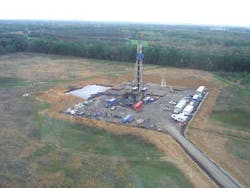Calgary’s Triangle Petroleum Corp. and Houston’s Kerogen Resources Inc. have begun drilling Arkansas’ Fayetteville shale. The partners equally share in a joint venture to explore 17,000 gross acres in Conway and Faulkner counties.
The Fayetteville shale in the Arkoma basin is touted as the geologic equivalent of the prolific Barnett shale found in the Fort Worth basin.
Triangle and Kerogen shot a 3D seismic program covering 12 sq miles in Conway County, Arkansas, in spring 2007, have drilled their first vertical test well, and plan to drill four more wells through the end of the year. The companies will use horizontal wells and multistage fracture stimulation to develop the reservoirs.
Fayetteville shale
The Fayetteville shale is one of eight major shale-gas plays in the US. The Fayetteville trend runs through the Arkoma basin in Arkansas; it’s the geologic equivalent of the Caney-Woodford shale found in the western Arkoma basin in eastern Oklahoma and the Barnett shale in North Texas.
Southwestern Energy Co. discovered the Fayetteville shale play in 2004 and is the largest acreage holder with about 900,000 net acres, followed by Chesapeake Energy Corp.
Southwestern Energy describes the Fayetteville as an unconventional-gas reservoir ranging in thickness from 50 to 550 ft and in depth from 1,500 ft to 6,500 ft.
As of June 30, 2007, Southwestern had drilled and completed 303 wells (as operator) in the Fayetteville shale play, including 246 horizontal wells (OGJ Online, Aug. 2, 2007). Southwestern drilled in 13 areas across eight Arkansas counties, including Franklin, Conway, Van Buren, Cleburne, Faulkner, and White.
Oklahoma City-based Chesapeake Energy calls the Fayetteville shale one of its six most important unconventional-gas plays. Chesapeake characterizes its Fayetteville leasehold as “second largest in the core area of the play,” (390,000 net acres) but says it’s the largest overall leasehold owner (1.1 million net acres).1
Chesapeake operates 12 rigs and plans to develop the field with horizontal wells and 80-acre spacing in the core area. The company said each well costs about $2.9 million to and will produce about 1.6 bcf-equivalent from 3,000-ft horizontal laterals.1
Other publicly held US operators involved in the Fayetteville shale play include: Contango Oil & Gas Co., Edge Petroleum Corp., Noble Energy Corp., and XTO Energy Inc.
Fracturing
Like other tight shale gas plays, the key to successful completions is hydraulic fracturing.
Schlumberger is the largest provider of frac services in the Fayetteville play and works under contract to Southwestern Energy. Of the 246 horizontal Fayetteville shale wells drilled by Southwestern, 219 were fracture stimulated with slick water or cross-linked gel fluids.
Although two of the largest frac service providers, Halliburton and BJ Services, have steered away from the area, Cudd Well Control and Calfrac Well Services Ltd. entered the Arkoma basin earlier this year.
Cudd Well Control is a division of Cudd Energy Services, a subsidiary of holding company RPC Inc. Cudd runs frac fleets in the Arkoma basin from an office in Elk City, Okla.
Calgary-based Calfrac established an office in Beebe, Ark., to service a 2-year take-or-pay contract signed with Chesapeake Energy late in 2006. Calfrac has relocated two frac equipment spreads to Arkansas; the first fleet started Mar. 8, 2007, and the second fleet began working June 4.2
Drilling
Triangle and Kerogen spud their first vertical test well, Ed Gordon WMA 1-10, in February 2007 with Nabors Rig 113, a conventional double (Fig. 1). The Conway County well reached the targeted 8,300 ft in April.
Eric Reigle, Arkoma team leader at Kerogen, told OGJ that drilling was successful using a variety of bits, predominantly PDC, and the company set 7-in. casing through the Fayetteville shale. The company plans to hydraulically fracture the well hydraulically in September.
Triangle and Kerogen expect to drill four more wells this year.
Triangle said the vertical test wells were planned to confirm Fayetteville shale-reservoir parameters and provide subsurface data to further refine the horizontal drilling program. The company plans to use the vertical wells to monitor stimulations of adjacent horizontal wells, after which it will convert them to horizontal producing wells.
Southwestern has drilled about 25 wells in Conway County, with initial test rates of 0.55 to 3.24 MMcfd (Jerome Carr 9-15/2-31H well), with an average of 1.49 MMcfd/well, according to the Arkansas Oil and Gas Commission and Capital One Southcoast Inc.3
Triangle
In addition to the Fayetteville shale project, Triangle Petroleum is focusing on projects in the US Rocky Mountains and shale in eastern Canada, where the company has recently acquired 484,000 gross acres in Nova Scotia and New Brunswick, according to Mark Gustafson, Triangle’s president and chief executive officer.
In July, Triangle divested its 27% interest in 12,100 gross acres in northeast Hill County, Tex., but retains its interest in eight Barnett shale wells.
The company’s US projects are run through subsidiary Triangle USA Petroleum Corp., and Canadian projects are handled through subsidiary Elmworth Energy Corp.
Kerogen
Privately held Kerogen Resources focuses on North American source rock shales. The company has acreage and experience in the Fort Worth basin (OGJ Online, Dec. 19, 2005). Kerogen worked with Schlumberger on a “stress-diversion” fracture pilot program, running large, multi-stage fracs in horizontal lateral wells. The Barnett pilot fracs used 5 million gal of fluid with 2.5 million lb of sand in five stages.
Reigle told OGJ that Kerogen also has nonoperated acreage in the Bakken play in the Williston basin. The Bakken formation was deposited during the Upper Devonian and Lower Mississippian periods and is now found across Montana and North Dakota and into the Canadian provinces of Manitoba and Saskatchewan (OGJ, Dec. 11, 2006).
References
- Second quarter operating results, Aug. 2, 2007, press release, www.chkenergy.com.
- Second quarter operating results, Aug. 9, 2007, conference call, www.calfrac.com.
- “Triangle Petroleum Corporation,” Capital One Southcoast Inc., Apr. 11, 2007.

